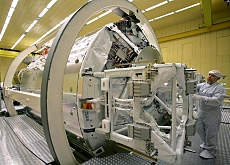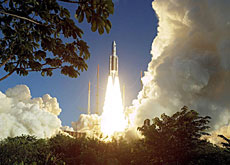Swiss experiments head to space station

A series of Swiss experiments are to be conducted on board the International Space Station (ISS), which is about to be visited by Nasa's shuttle, Discovery.
Discovery, which lifted off on Tuesday, will deliver equipment to be used by the European Space Agency’s astronaut, Thomas Reiter, who will begin a six-month mission in space.
The Swiss experiments are medical-based. One is a device known as a Percutaneous Electrical Muscle Stimulator, designed by Syderal, a company based near Neuchâtel.
“The device can measure muscle loss and osteoporosis, common among long-term space dwellers,” Syderal’s head of research and development, Arnaud Gisiger told swissinfo.
The stimulator’s main use is for human muscular research. Alone, it can be used to maintain muscle strength.
It delivers electrical stimulation to the arm and leg muscle groups of the test subject in a zero-gravity environment.
It is built to work with other instruments, in particular the muscle atrophy research and exercise system. The device will be integrated in the Human Research Facility on board the ISS.
The second experiment headed aloft with Discovery was developed in part by researchers at Zurich University. The Eye Tracking Device (ETD) looks closely at relationship between a person’s eyes and their sense of balance.
Scientists hope that by understanding how this relationship adapts to weightlessness, they can comprehend a little better the cause of space sickness as well as vertigo and nausea back on Earth.
The ETD, which has already been used since 2004 and Esa’s Delta mission to the space station, tracks eye movements with miniature cameras mounted on special glasses.
White blood cells
Another Swiss experiment will be headed for the ISS in September. Reiter will carry out research for Zurich’s Federal Institute of Technology and spin-off company Zero-g LifeTec looking at the effects of weightlessness on white blood cells.
A Soyuz spacecraft launched from the Baikonur launch site in Kazakhstan will deliver blood samples for the Leukin experiment. The German astronaut will simulate a blood infection by applying a natural plant compound and record the immune reaction of the T-lymphocyte cells.
“Reiter was especially trained in April by Switzerland’s own astronaut, Claude Nicollier, so we are pretty confident he can get the job done,” said the head of LifeTec, Augusto Cogoli.
The results will be analysed back on the ground in San Francisco by a former astronaut.
It’s a case of hopefully second time lucky for Leukin. The experiment was already on board the shuttle Columbia that broke up on re-entering the Earth’s atmosphere in 2003, killing all its occupants and destroying the scientific data amassed during the mission.
The project was first proposed back in 1997 according to Cogoli, but waiting has however had its upside.
“The delays haven’t been all bad news fortunately,” he told swissinfo. “We have been able to improve our analysis technology, so the results should be better.”
swissinfo with agencies
Switzerland was a founding member of the European Space Agency, but it also collaborates with other agencies.
The Swiss space industry includes 28 research institutes and 54 companies. Apart from Contraves, all these firms have fewer than 200 employees.
They specialise mostly in ground equipment, optical apparatuses, telecommunications systems, clocks, robotic machinery, microgravity research, and weather surveillance.
Switzerland is also the homeland of Claude Nicollier, astrophysicist, test pilot and astronaut. He was the first foreigner granted mission specialist status by Nasa.

In compliance with the JTI standards
More: SWI swissinfo.ch certified by the Journalism Trust Initiative











You can find an overview of ongoing debates with our journalists here . Please join us!
If you want to start a conversation about a topic raised in this article or want to report factual errors, email us at english@swissinfo.ch.